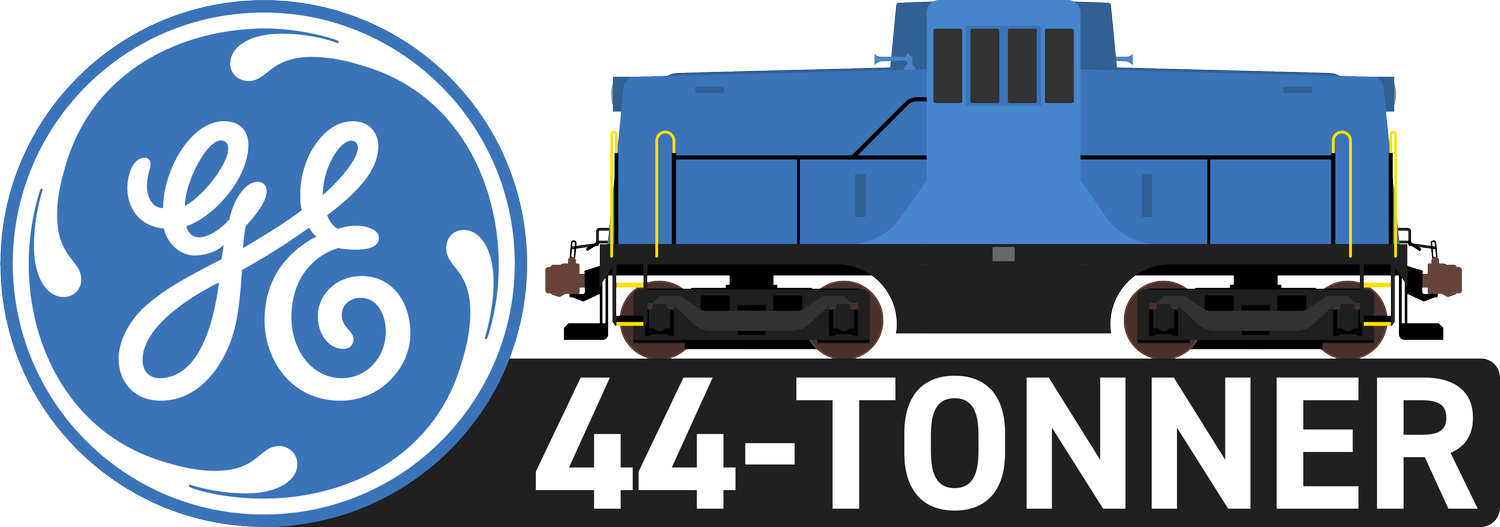HISTORY OF THE GE 44-TONNER
(December of 1945 advertising booklet, Eric Bickleman collection)
The General Electric 44-tonner was a diesel-electric switcher and industrial locomotive produced between September of 1940 and October of 1956 at GE’s plant in Erie, Pennsylvania. A total of 386 of these diminutive center-cab locomotives were produced, and they saw service everywhere from the United States to Saudi Arabia. The 44-tonner’s widespread adoption for small switching operations became one of the earliest symbols of the railroad industry’s imminent changeover from steam to diesel power.
With the transition from steam to diesel already underway in the late 1930s, steam locomotive firemen were faced with the possibility of becoming unneeded in modernized railroad operations. To protect the firemen’s jobs, a 1937 labor agreement included the “90,000 Pound Rule,” which required any locomotive 45 tons or more to carry a fireman in addition to the engineer. The GE 44-tonner was designed to skirt this requirement and allow for a single person to operate the locomotive as intended, without the addition of an unnecessary fireman.
The 44-tonner’s centered cab and good visibility, coupled with its maximum speed of only 35 miles per hour, made it a popular choice for industrial operations and small switching operations from the 1940s to present day. Each locomotive was powered by a pair of diesel engines, with each engine powering its own GE electric generator. Each generator supplied 600-volt DC power to electric traction motors mounted on the two axles on the truck beneath that motor/engine combination. In this way, it was possible to operate a 44-tonner with only one of its two diesel engines providing power to one of its two trucks, a fact that GE advertised (“Each power plant drives one truck, and operates independently of the other except that both are controlled by one throttle…. One power plant will, in an emergency, operate the locomotive at half its rated capacity.”).
Of the 386 44-tonners built, 363 were constructed with a pair of Caterpillar D17000 engines (more info on this engine is available here). Introduced in 1935 as the first diesel engine produced specifically for non-tractor applications, these V8 engines produced 190 horsepower each, giving the 44-tonner locomotives a total of 380 horsepower. GE also offered other diesel engine options for the 44-tonner, including a Hercules six-cylinder DFXD (175 horsepower each, applied to nine locomotives) and a Buda six-cylinder 6DH1742 (205 horsepower each, applied to ten locomotives). Following the discontinuation of the D17000 by 1956, the last four 44-tonners produced used Caterpillar’s new six-cylinder D342 diesel engine (191 horsepower each, designed for installation in the Caterpillar D8 bulldozer). All five of the locomotives involved in our project are fitted with their original Caterpillar D17000s.
The 1943 base price for a Caterpillar D17000-equipped 44-tonner was $37,500; a locomotive with the Buda 6DH1742 cost an additional $650. A deadman’s pedal (later made a standard safety feature on all railroad locomotives) and even the speedometer were considered add-on items, available for $250 and $210 (respectively). Even with the somewhat high purchase price ($37,500 in 1943 dollars is $643,500 in 2023 dollars), early purchasers of the 44-tonner were impressed by its low maintenance requirements and equally low fuel costs, especially compared to the steam locomotives that still ruled the rails in the 1940s. GE toted these savings in its 1940s advertising, noting that “returns often reach 20 to 40 percent on the purchase price.” A 44-tonner operating on the Arcade & Attica Railroad for 10 hours a day instead of a steam locomotive saved the railroad over $6,000 a year in 1945 on fuel alone, and the Milwaukee Road reported saving $8,400 a year on fuel and maintenance required to operate a 44-tonner versus a steam locomotive.
The 44-tonners proved to be versatile, adept, and reliable locomotives, but as traffic patterns changed and railcar sizes and train lengths increased as the diesel era took hold in the 1950s, many 44-tonners found themselves being sold and resold to new homes from the 1960s to 1980s. Despite the fact that the last 44-tonner was built over half a century ago, a large number of them survive today, with several still in revenue freight service. Still more are active in museums or other operational capacities, or are displayed in a historical context.
